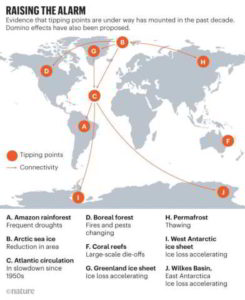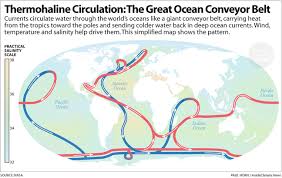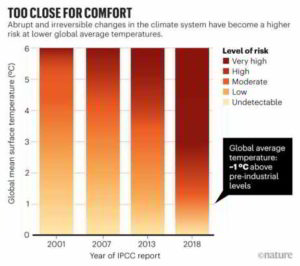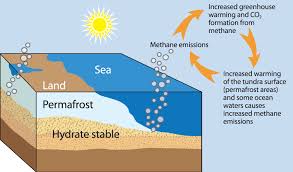
Views: 81
– The growing threat of abrupt and irreversible climate changes must compel political and economic action on emissions.
Minapim by Hernan Valenzuela: Politicians, economists and even some natural scientists have tended to assume that tipping points in the Earth system — such as the loss of the Amazon rainforest or the West Antarctic ice sheet — are of low probability and little understood. Yet evidence is mounting that these events could be more likely than was thought, have high impacts and are interconnected across different biophysical systems, potentially committing the world to long-term irreversible climate change.
- The world could be heading toward tipping points in the climate system.
- In an interconnected climate system, passing one tipping point may trigger a cascade of irreversible changes.
- As the world continues to warm, some call for urgent global action to avert an “existential threat to civilization.”
We may be about to pass – or may already have passed – tipping points in the Earth’s climate, according to a group of leading scientists.
The scientists analyzed evidence on these nine components of our climate system – called “tipping points” because they are under growing threat of abrupt and irreversible changes.
- Amazon rainforest – Frequent Droughts
- Arctic sea ice – Reduction in Area
- Atlantic circulation – In slowdown since 1950
- Boreal forests – Firest and pests changing
- Coral reefs – large scale die-offs
- Greenland ice sheet – Ice loss accelerating
- Permafrost – Thawing
- West Antarctic ice sheet – Ice loss accelerating
- Part of East Antarctica – East Antarctica ice loss accelerating
Passing one of these tipping points – from the collapse of the West Antarctic ice sheet to the loss of coral reefs and the Amazon rainforest – may increase the risk of crossing others, the scientists write in a commentary article in the journal Nature.
Ocean and atmospheric circulation and feedback between these interconnected climate shifts could accelerate the warming process, they warn, triggering a cascade of tipping points or even to a global tipping point – and a less habitable, “hothouse” Earth.
These are the world’s climate tipping points – and we’re getting close to the point of no return.

Climate dominoes
How might such a climatic collapse happen? The authors point to the loss of Arctic sea-ice and the melting of Greenland’s ice sheet driving fresh water into the North Atlantic. They say this could have contributed to a 15% slowdown since the mid-20th century of the Atlantic Meridional Overturning Circulation (AMOC), a system of ocean currents that moves warm water northwards.
“Rapid melting of the Greenland ice sheet and further slowdown of the AMOC could destabilize the West African monsoon, triggering drought in Africa’s Sahel region,” they write.
“A slowdown in the AMOC could also dry the Amazon, disrupt the East Asian monsoon and cause heat to build up in the Southern Ocean, which could accelerate Antarctic ice loss.”
In their opinion, the West Antarctic ice sheet might already have passed a tipping point.
The “grounding line” at which ice, ocean and bedrock meet in a glacial system called the Amundsen Sea Embayment is retreating irreversibly.
Its collapse could destabilize the rest of the West Antarctic ice sheet like “toppling dominoes,” according to one computer model study, and lead to about 3 metres of sea-level rise “on a timescale of centuries to millennia.”
The latest research suggests the Wilkes Basin, which is part of the East Antarctic ice sheet, might be similarly unstable – which could add another 3-4 metres to sea level a century or more from now.
‘An existential threat to civilization’
Some scientists disagree with the global tipping point argument and say it is speculation.
But the authors, led by Timothy Lenton, Professor of Climate Change and Earth System Science at the UK’s University of Exeter, argue that, despite the uncertainty, the stakes are so high it’s too risky to bet against.
They say “to err on the side of danger is not a responsible option,” and call for an international emergency response.
“If damaging tipping cascades can occur and a global tipping point cannot be ruled out, then this is an existential threat to civilization. No amount of economic cost–benefit analysis is going to help us. We need to change our approach to the climate problem.”
Two decades ago, scientists thought it would take a rise in global average surface temperature of 5°C above pre-industrial levels to reach tipping points in the climate system. Recent Intergovernmental Panel on Climate Change (IPCC) reports suggest this could occur between 1°C and 2°C.
The risk of irreversible changes to the climate system is high.

The world has already warmed by more than 1°C. Even if countries implement their current pledges to reduce greenhouse-gas emissions, we are likely to see at least 3°C, despite the Paris agreement to keep warming well below 2°C.
Speaking ahead of the UN’s Climate Change Conference COP25 in Madrid, UN Secretary-General Antonio Guterres said efforts to reach global targets have been “utterly inadequate” and climate change could pass the point of no return.
He emphasized that the world still has the means to keep warming below 1.5°C, but “what is lacking is political will.”
Sources: World Economic Forum Nature 575, 592-595 (2019) doi: 10.1038/d41586-019-03595-0
References: Timothy M. Lenton, Johan Rockström, Owen Gaffney, Stefan Rahmstorf, Katherine Richardson, Will Steffen , Hans Joachim Schellnhuber
Related article: Invading the Amazon – Proposes article from the country that most pollutes with CO2
